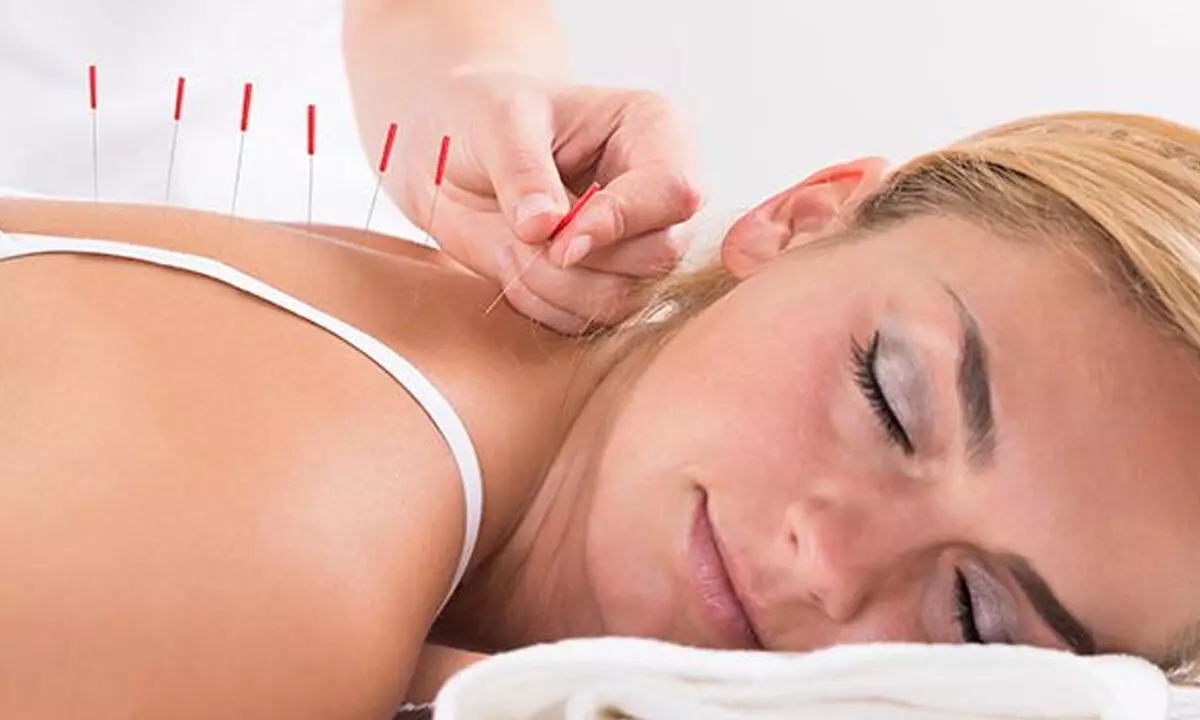Live
- BGT: Rohit, KL Rahul suffer injury scares ahead of Boxing Day Test
- PM Modi Visits Indian Labour Camp And Engages With Diaspora In Kuwait
- South Korea: Main opposition urges acting president to sign special counsel bills or face consequences
- Central PSUs record 47 per cent jump in net profit for 2023-24, market cap doubles
- Man In Madhya Pradesh Dies By Suicide, Leaves Video Alleging Harassment
- AAP Likely To Replace Shoaib Iqbal With Son Aaley Muhammad Iqbal For Matia Mahal Seat
- Multi-Storey Building Collapse In Mohali Triggers Massive Rescue Operation
- Anti-Corruption Officers Assaulted By Revenue Clerks In Uttar Pradesh
- Earthquake tremors felt again in Prakasam district
- G Trisha, spinners star as India win inaugural U19 Women’s Asia Cup title
Just In

Acupuncture for Hypertension: How does it work?
Hypertension or high blood pressure poses a significant risk to both mortality and disability rates in India
Hypertension or high blood pressure poses a significant risk to both mortality and disability rates in India. If you are living with high blood pressure, your healthcare team may recommend incorporating lifestyle changes and, in some cases, medication to manage your symptoms. However, alongside these conventional approaches, acupuncture, a therapeutic method derived from traditional Chinese medicine (TCM), may offer potential benefits as part of your treatment regimen.
For approximately 3,000 years, acupuncture has been utilised to address various health issues. This practice involves the insertion of ultra-thin, flexible needles into specific acupoints on the body, stimulating the body’s natural healing processes. Additionally, modern acupuncture techniques may incorporate electro acupuncture, which involves the application of an electric current through acupuncture needles.
Blood Pressure and Hypertension
Blood pressure (BP) refers to the force that blood exerts on the walls of arteries during circulation. It is determined by the contraction of the heart muscle and is measured in systolic (during heart contraction) and diastolic (during heart relaxation) pressures. Typically, BP is denoted by the systolic pressure preceding the diastolic pressure, such as 120/80 which is considered normal.
Systolic blood pressure represents the maximum pressure exerted during a heartbeat when blood is being pumped out of the heart into the body’s arteries. On the other hand, diastolic blood pressure is the lowest pressure recorded between heartbeats when the heart is filling with blood.
BP can rise temporarily during exercise or stress but when it remains persistently high, even at rest, it can damage the arteries. Stage 1 hypertension is characterised by a systolic reading of 130-139 or a diastolic reading of 80-89. A reading of 140/90 or higher is classified as stage 2 hypertension. A hypertensive crisis is indicated by a systolic rate of over 180 or a diastolic rate over of 120.
High BP can lead to serious health problems such as heart disease, heart failure, stroke, kidney damage, vision loss, memory loss, and cognitive decline.
How does Acupuncture Help to Regulate Blood Pressure?
While the exact mechanisms of how acupuncture works are not yet fully understood from a scientific perspective, it is believed that the stimulation of certain points in the body can have an impact on the central nervous system, influencing blood flow and the production of key hormones.
Regarding hypertension, acupuncture may assist in regulating blood pressure by affecting the hormones involved in the renin-angiotensin-aldosterone system (RAAS). This system is responsible for maintaining blood pressure levels and fluid-electrolyte balance.
In particular, acupuncture may influence the presence of hormones and enzymes related to the RAAS in the bloodstream and stimulate receptors in the body that regulate blood pressure.
Moreover, acupuncture could potentially act on the limbic system, leading to increased levels of dopamine, a neurotransmitter that plays a significant role in the brain’s reward system.
According to a study conducted recently, dopamine has the potential to decrease oxidative stress, which is characterised by an overabundance of free radicals, thereby assisting in maintaining healthy blood pressure levels.
What do Studies Suggest?
A recent study conducted at the University of California-Irvine (UCI) has provided the first scientific confirmation of the benefits of an ancient Chinese medical technique for patients suffering from mild to moderate hypertension. The research, published in the Medical Acupuncture journal, revealed that electro acupuncture, a type of acupuncture that uses low-intensity electrical pulses through needles inserted at specific points on the body, can lower blood pressure in patients with hypertension for up to six weeks. According to the researchers, these findings indicate that regular use of electro acupuncture could help individuals manage their blood pressure, potentially reducing their risk of heart disease and stroke in the long term.
In a 2007 clinical study published in Circulation, it was suggested that acupuncture, performed according to the precise specifications of ancient Chinese tradition, could be an effective treatment for mild hypertension, with some individuals experiencing results comparable to those achieved through single-drug therapy or aggressive lifestyle changes such as exercise and salt restriction. Additionally, a 2019 review concluded that combining acupuncture with Western medicine approaches could be more effective in improving hypertension than Western medicine alone.
Research indicates that acupuncture may provide temporary relief for individuals with high blood pressure. Combining acupuncture with standard blood pressure medication may have a greater effect on reducing blood pressure compared to medication alone.
It is generally safe to use acupuncture alongside most blood pressure medications. However, it is crucial to seek treatment from a licensed and board-certified acupuncturist to ensure safe and effective therapy.

© 2024 Hyderabad Media House Limited/The Hans India. All rights reserved. Powered by hocalwire.com







